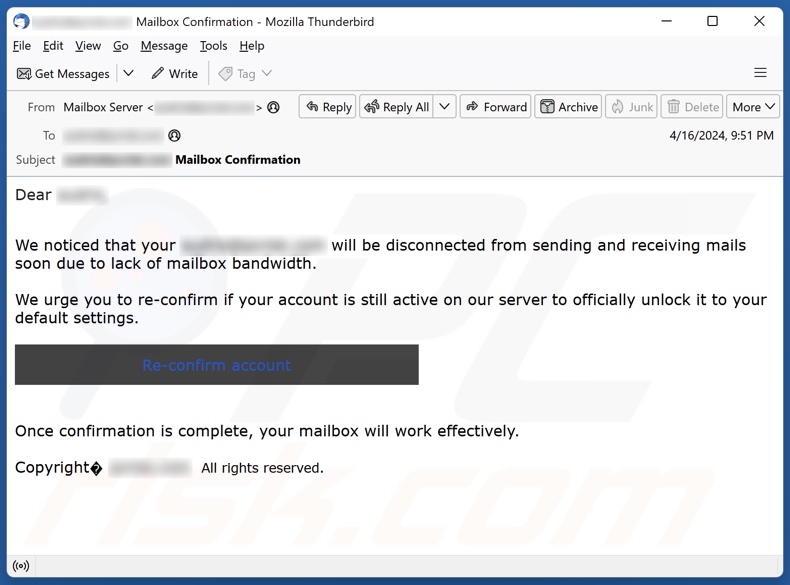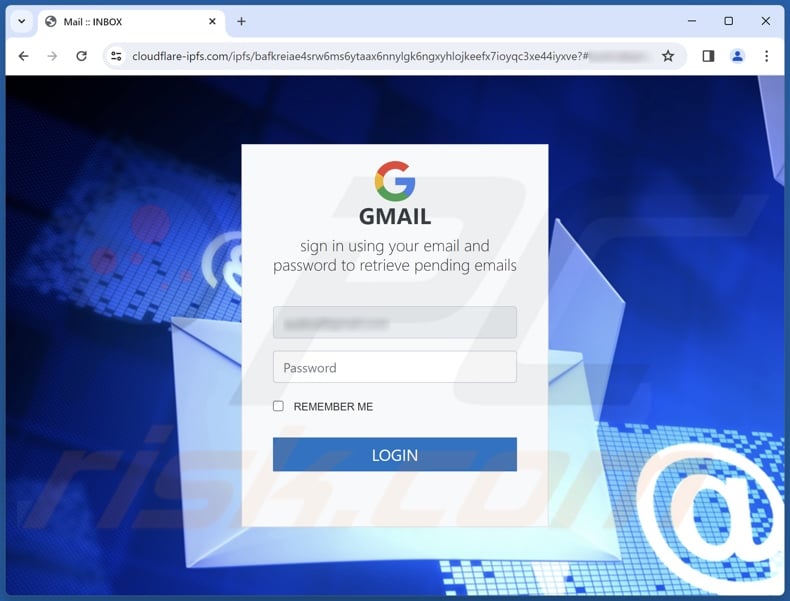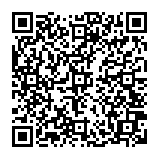Avoid losing your account via fake "Lack Of Mailbox Bandwidth" emails
![]() Written by Tomas Meskauskas on
Written by Tomas Meskauskas on
What kind of email is "Lack Of Mailbox Bandwidth"?
After reading the "Lack Of Mailbox Bandwidth" email, we determined that it is spam. This fraudulent message states that the recipient's email account will lose functionality due to bandwidth issues. This phishing mail targets log-in credentials (email passwords).

"Lack Of Mailbox Bandwidth" email scam overview
The spam email with the subject "[recipient's_email_address] Mailbox Confirmation" (may vary) claims that the recipient's account was disconnected (i.e., lost the ability to send/receive mail). The reason for this is a "lack of mailbox bandwidth". The mailbox can be reconfirmed as active on the server, thus restoring it to default settings and operational status.
It must be emphasized that these claims are false, and this scam mail is not associated with any genuine service providers.
After "Re-confirm account" is clicked, we learned that the letter redirects to a phishing website. It is disguised as an email sign-in page requesting visitors to reaccess their accounts to retrieve pending messages. Information provided to this webpage is recorded and sent to scammers.
Through a stolen email, cyber criminals can access sensitive data stored on it, and they might even gain control over accounts and platforms registered through the mail.
To elaborate on the potential misuse, scammers can steal the identities of account owners (e.g., emails, social networking, social media, messengers, chats, etc.) and ask the contacts/friends for loans or donations, promote scams, and spread malware.
Furthermore, confidential/compromising content found on data storage or similar platforms could be used for blackmail or other malicious purposes. What is more, hijacked finance-related accounts (e.g., e-commerce, money transferring, digital wallets, online banking, etc.) can be used to make fraudulent transactions or online purchases.
In summary, victims of scam emails like "Lack Of Mailbox Bandwidth" can experience serious privacy issues, financial losses, and even identity theft.
If you have already entered your log-in credentials into a phishing website – immediately change the passwords of all possibly exposed accounts and inform their official support.
| Name | "Lack Of Mailbox Bandwidth" phishing email |
| Threat Type | Phishing, Scam, Social Engineering, Fraud |
| Fake Claim | Recipient's email risks being disconnected (losing functionality) due to a lack of mailbox bandwidth. |
| Symptoms | Unauthorized online purchases, changed online account passwords, identity theft, illegal access of the computer. |
| Distribution methods | Deceptive emails, rogue online pop-up ads, search engine poisoning techniques, misspelled domains. |
| Damage | Loss of sensitive private information, monetary loss, identity theft. |
| Malware Removal (Windows) | To eliminate possible malware infections, scan your computer with legitimate antivirus software. Our security researchers recommend using Combo Cleaner. |
Phishing spam campaign examples
"HSBC Transfer Request", "Notification Concerning Your Netflix Account", and "Consignment Box" are just a couple examples of phishing emails we have investigated recently.
Various scams are promoted through deceptive messages, including phishing, tech support, sextortion, inheritance, lottery, refund, etc. Spam mail is also used to distribute malware (e.g., trojans, ransomware, etc.).
Due to how widespread this mail is and how well-made it can be – we highly recommend vigilance with incoming emails, PMs/DMs, SMSes, and other messages.
How do spam campaigns infect computers?
Spam campaigns are commonly utilized in malware proliferation. These emails/messages can include malicious files as attachments or download links. The files can be documents (e.g., PDF, Microsoft Office, Microsoft OneNote, etc.), archives (ZIP, RAR, etc.), executables (.exe, .run, etc.), JavaScript, and so on.
Once such a file is opened – the infection chain is initiated. However, some formats can require additional user interaction to jumpstart malware download/installation processes. For example, Microsoft Office files need users to enable macro commands (i.e., editing/content), while OneNote documents require them to click on embedded files/links.
How to avoid installation of malware?
It is essential to exercise caution with incoming emails and other messages. Attachments or links found in suspect/irrelevant mail must not be opened, as they can be virulent. However, malware is not spread exclusively via spam mail.
Therefore, we also advise being careful while browsing, as fraudulent and dangerous online content typically appears legitimate and innocuous.
Another recommendation is to download only from official and verified channels. Additionally, all programs must be activated and updated using genuine functions/tools, as illegal activation ("cracking") tools and third-party updaters may contain malware.
It is paramount to have a dependable anti-virus installed and kept up-to-date. Security software must be used to perform regular system scans and to remove threats and issues. If you've already opened malicious attachments, we recommend running a scan with Combo Cleaner Antivirus for Windows to automatically eliminate infiltrated malware.
Text presented in the "Lack Of Mailbox Bandwidth" spam email letter:
Subject: - Mailbox Confirmation
Dear -,
We noticed that your - will be disconnected from sending and receiving mails soon due to lack of mailbox bandwidth.
We urge you to re-confirm if your account is still active on our server to officially unlock it to your default settings.
Re-confirm account
Once confirmation is complete, your mailbox will work effectively.
Copyright - All rights reserved.
Screenshot of the phishing website promoted by the "Lack Of Mailbox Bandwidth" spam campaign:

Instant automatic malware removal:
Manual threat removal might be a lengthy and complicated process that requires advanced IT skills. Combo Cleaner is a professional automatic malware removal tool that is recommended to get rid of malware. Download it by clicking the button below:
▼ DOWNLOAD Combo Cleaner
By downloading any software listed on this website you agree to our Privacy Policy and Terms of Use. To use full-featured product, you have to purchase a license for Combo Cleaner. 7 days free trial available. Combo Cleaner is owned and operated by Rcs Lt, the parent company of PCRisk.com read more.
Quick menu:
- What is "Lack Of Mailbox Bandwidth" phishing email?
- Types of malicious emails.
- How to spot a malicious email?
- What to do if you fell for an email scam?
Types of malicious emails:
![]() Phishing Emails
Phishing Emails
Most commonly, cybercriminals use deceptive emails to trick Internet users into giving away their sensitive private information, for example, login information for various online services, email accounts, or online banking information.
Such attacks are called phishing. In a phishing attack, cybercriminals usually send an email message with some popular service logo (for example, Microsoft, DHL, Amazon, Netflix), create urgency (wrong shipping address, expired password, etc.), and place a link which they hope their potential victims will click on.
After clicking the link presented in such email message, victims are redirected to a fake website that looks identical or extremely similar to the original one. Victims are then asked to enter their password, credit card details, or some other information that gets stolen by cybercriminals.
![]() Emails with Malicious Attachments
Emails with Malicious Attachments
Another popular attack vector is email spam with malicious attachments that infect users' computers with malware. Malicious attachments usually carry trojans that are capable of stealing passwords, banking information, and other sensitive information.
In such attacks, cybercriminals' main goal is to trick their potential victims into opening an infected email attachment. To achieve this goal, email messages usually talk about recently received invoices, faxes, or voice messages.
If a potential victim falls for the lure and opens the attachment, their computers get infected, and cybercriminals can collect a lot of sensitive information.
While it's a more complicated method to steal personal information (spam filters and antivirus programs usually detect such attempts), if successful, cybercriminals can get a much wider array of data and can collect information for a long period of time.
![]() Sextortion Emails
Sextortion Emails
This is a type of phishing. In this case, users receive an email claiming that a cybercriminal could access the webcam of the potential victim and has a video recording of one's masturbation.
To get rid of the video, victims are asked to pay a ransom (usually using Bitcoin or another cryptocurrency). Nevertheless, all of these claims are false - users who receive such emails should ignore and delete them.
How to spot a malicious email?
While cyber criminals try to make their lure emails look trustworthy, here are some things that you should look for when trying to spot a phishing email:
- Check the sender's ("from") email address: Hover your mouse over the "from" address and check if it's legitimate. For example, if you received an email from Microsoft, be sure to check if the email address is @microsoft.com and not something suspicious like @m1crosoft.com, @microsfot.com, @account-security-noreply.com, etc.
- Check for generic greetings: If the greeting in the email is "Dear user", "Dear @youremail.com", "Dear valued customer", this should raise suspiciousness. Most commonly, companies call you by your name. Lack of this information could signal a phishing attempt.
- Check the links in the email: Hover your mouse over the link presented in the email, if the link that appears seems suspicious, don't click it. For example, if you received an email from Microsoft and the link in the email shows that it will go to firebasestorage.googleapis.com/v0... you shouldn't trust it. It's best not to click any links in the emails but to visit the company website that sent you the email in the first place.
- Don't blindly trust email attachments: Most commonly, legitimate companies will ask you to log in to their website and to view any documents there; if you received an email with an attachment, it's a good idea to scan it with an antivirus application. Infected email attachments are a common attack vector used by cybercriminals.
To minimise the risk of opening phishing and malicious emails we recommend using Combo Cleaner Antivirus for Windows.
Example of a spam email:

What to do if you fell for an email scam?
- If you clicked on a link in a phishing email and entered your password - be sure to change your password as soon as possible. Usually, cybercriminals collect stolen credentials and then sell them to other groups that use them for malicious purposes. If you change your password in a timely manner, there's a chance that criminals won't have enough time to do any damage.
- If you entered your credit card information - contact your bank as soon as possible and explain the situation. There's a good chance that you will need to cancel your compromised credit card and get a new one.
- If you see any signs of identity theft - you should immediately contact the Federal Trade Commission. This institution will collect information about your situation and create a personal recovery plan.
- If you opened a malicious attachment - your computer is probably infected, you should scan it with a reputable antivirus application. For this purpose, we recommend using Combo Cleaner Antivirus for Windows.
- Help other Internet users - report phishing emails to Anti-Phishing Working Group, FBI’s Internet Crime Complaint Center, National Fraud Information Center and U.S. Department of Justice.
Frequently Asked Questions (FAQ)
Why did I receive this email?
Spam emails are not personal, even if they include details relevant to the recipients. This mail is distributed in large-scale operations – hence, thousands of users receive identical messages.
I have provided my personal information when tricked by this spam email, what should I do?
If you have provided your account credentials – change the passwords of all possibly exposed accounts and inform their official support without delay. And if you've disclosed other private data (e.g., ID card details, passport photos/scans, credit card numbers, etc.) – immediately contact relevant authorities.
I have read a spam email but didn't open the attachment, is my computer infected?
No, merely reading an email poses no infection threat. Devices are compromised when malicious attachments or links are opened/clicked.
I have downloaded and opened a file attached to a spam email, is my computer infected?
If the opened file was an executable (.exe, .run, etc.) – most likely, yes – since these files cause infections almost without fail. However, you might have avoided triggering an infection if it was a document (.doc, .xls, .pdf, .one, etc.). These formats may require additional actions to begin downloading/installing malware (e.g., enabling macro commands, clicking embedded content, etc.).
Will Combo Cleaner remove malware infections present in email attachments?
Yes, Combo Cleaner is designed to scan computers and eliminate all manner of threats. It can detect and remove most of the known malware infections. Note that running a complete system scan is key since sophisticated malicious software typically hides deep within systems.


▼ Show Discussion